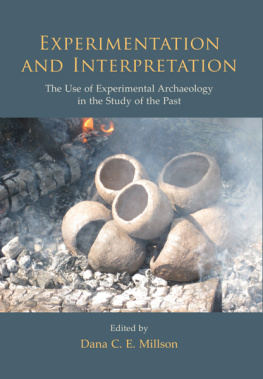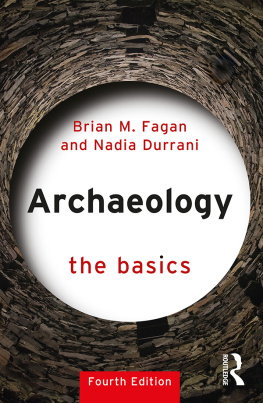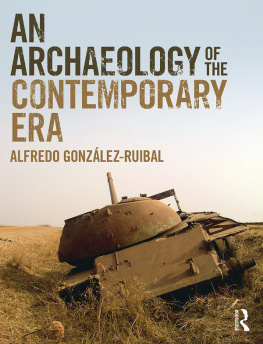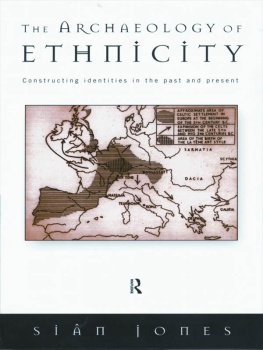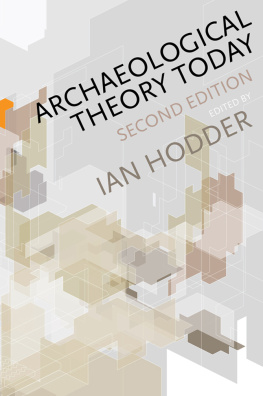
Published by
Oxbow Books, Oxford
Oxbow Books and the individual authors 2010
ISBN 978-1-84217-399-2
EPUB ISBN: XXXXXXXXXXXXX
This book is available direct from
Oxbow Books, Oxford
(Phone: 01865-241249; Fax: 01865-794449)
and
The David Brown Book Company
PO Box 511, Oakville, CT 06779, USA
(Phone: 860-945-9329; Fax: 860-945-9468)
or from our website
www.oxbowbooks.com
A CIP record for this book is available from the British Library
Library of Congress Cataloging-in-Publication Data
Experimentation and interpretation : the use of experimental archaeology in the study of the past / edited
by Dana C.E. Millson.
p. cm.
Papers from a session held at the annual Theoretical Archaeological Group (TAG) Conference in
Southampton, England, Dec. 2008.
Includes bibliographical references.
ISBN 978-1-84217-399-2
1. Experimental archaeology--Europe--Congresses. 2. Experimental archaeology--England--Congresses.
3. Excavations (Archaeology)--Europe--Congresses. 4. Excavations (Archaeology)--England--Congresses.
5. Material culture--Europe--History--Congresses. 6. Material culture--England--History--Congresses. 7.
Europe--Antiquities--Congresses. 8. England--Antiquities--Congresses. 9. Archaeology--Methodology-
Congresses. 10. Archaeology--Philosophy--Congresses. I. Millson, Dana C. E. II. Theoretical Archaeology
Group (England). Conference (2008 : Southampton, England)
CC81.5.E965 2010
930.1--dc22
2010041655
Front cover: Experimental firing of Neolithic replica pots. D. Millson
Printed in Great Britain by
Hobbs the Printers, Tott on, Hampshire
List of Figures
List of Tables
1. Introduction
Dana C. E. Millson
In December 2008, at the annual Theoretical Archaeological Group (TAG) conference in Southampton, I organized a session which focused on the use of experimentation in archaeology. Much curiosity ensued, questioning why such a practical part of archaeology should be discussed in a theory conference. Indeed, archaeology is a field which spans two (sometimes opposing) philosophies that of science and arts which is best described by Jones (2002, 1) as an archaeology of two cultures. It is this dichotomy which makes archaeology a strong discipline, capable of drawing knowledge from some of the most fragmentary evidence; but it is also what has caused much confusion about what archaeology is and how it should be conducted. This has caused countless arguments and even fissures within the discipline. In the midst of all this is Experimental Archaeology, which approaches the archaeological record in a scientific way, but in reality, is inextricably tied to the humanistic interpretations we create. It is how we test our hypotheses and then progress to develop new theories, and perhaps it is for this reason the session proposal was accepted in the first place. It is of no doubt, however, that the contributors projects, which demonstrate the interesting and novel ways in which Experimental Archaeology can be used, and the fascinating results it can offer, is what made the session so successful that, by the second half, the audience stretched into the corridor.
A Little Bit of History...
Experimental Archaeology is not a new idea, but an implement which has been used since the days of the antiquarians (Coles 1973, 1314; Forrest 2008, 6265). This often involved experimentation with actual artifacts that had been excavated, but some work, such as Pitt-Rivers (1876, 38283) study at Cissbury, Sussex, involved the construction of replicas to perform planned experiments. Pitt-Rivers reconstructed antler picks that were found on-site and used them to dig ditches of the same depth and size as those at the hillfort. The results proved Pitt-Rivers inference correct that the ditches had been dug using the picks and that it could be done quickly, ...we had made an excavation 3 feet square and 3 feet deep in an hour and a half...it would have taken us twelve hours to form the longest gallery found... (Pitt-Rivers 1876, 382).
However, it was not until the 1960s, particularly with the work of Louis Binford and followers of the New Archaeology, that Experimental Archaeology became established as a practice in its own right. After realizing that the culture-historical approach was not sufficient enough to give clear detail about past culture, Binford searched for new ways to approach archaeology:
An accurate and meaningful history is more than a generalized narrative of the changes in composition of the archaeological record through time...If we hope to achieve the aim of reconstructing culture history, we must develop means for using archaeological remains as a record of the past and as a source of data for testing propositions which we set forth regarding past events, rather than a record we can read according to a set of a priori rules or interpretive principles whose application allow the skilled interpreter to reconstruct the past (Binford 1968, 11).
In contrast to past theoretical frameworks, his was a discipline which did not follow a straight path where new information was simply added to the story, but more of fibrous route where, ...every time you learn something new, it impacts on everything you ever thought you knew in some sense (Sabloff 1998, 42, quoting Binford). Since he had first been educated in the natural sciences, taking a scientific approach, particularly testing hypotheses with experimentation, was an obvious step and he introduced the use of methods from other disciplines, particularly anthropology and the natural sciences.
In the early 1980s, however, a new movement began to develop, which criticized and rejected New Archaeology and its sub-disciplines. The Post-processualists argued that science was insufficient in the study of past culture because humans do not behave like organisms and cultures vary so greatly that scientific laws cannot be applied to them the same way as they can be to biological processes. It was further argued that objectivity could not be fully achieved when studying culture, because the bias of our own cultural values would always interfere with our interpretation (Trigger 2008, 45657; Shanks and Tilley 1987). Moreover, they argued, the New Archaeologists, or Processualists, had completely ignored the fundamental aspects of culture that could not be considered empirically, like ideology and religion (Trigger 2008, 45051; Sabloff 1998, 91). As part of this backlash, the methods of the Processualists, Experimental Archaeology included, were largely abandoned or marginalized.
The criticism against treating archaeology solely as a science and attempting complete objectivity is valid; however, the rejection of science in archaeology was the Post-processualists greatest weakness. The discipline had formerly been teetering on one foot in the scientific sector, with the Post-processualist movement, but it now took an equally imbalanced shift in the opposite direction. It is true that not everyone working in the field at the time took on these ideas, or even entered the debate, but the literature enforces an atmosphere of revolution where one was obliged to choose a side, and be attacked either way.
By the 1990s, the Post-processualists points had been made and archaeology had been changed, and it was at this point the main flaws of a completely humanistic approach began to be observed (Trigger 2008, 516). Along with this was the impetus of new scientific and technological applications that could be used in archaeology to gain new forms of data to support theory (Brothwell & Pollard 2001, xix; Trigger 2008, 540). The development of residue analysis, using mass spectrometry, was underway (Evershed
Next page
